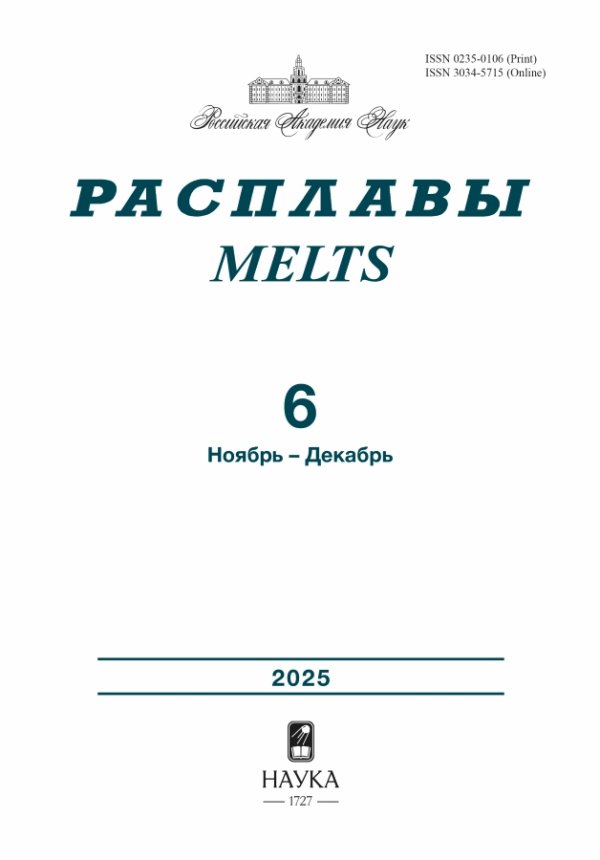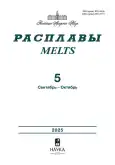Investigation of Saturated Vapor Pressure of K–Pb Melts
- Authors: Ivenko V.M.1
-
Affiliations:
- Institute of High-Temperature Electrochemistry, Ural Branch of the Russian Academy of Sciences
- Issue: No 5 (2025)
- Pages: 467-475
- Section: Articles
- URL: https://bakhtiniada.ru/0235-0106/article/view/309552
- DOI: https://doi.org/10.31857/S0235010625050058
- ID: 309552
Cite item
Abstract
The saturated vapor pressure of liquid lead alloys with alkali metals has been studied only for lead alloys with lithium and sodium. In [1], the saturated vapor pressure of lead-lithium alloys (0.05 < xLi < 0.95) was studied in combination with massspectrometric measurements at 700–900 K. Fischer and Johnson studied lead-sodiumalloys using the quasi-static method (0.15 < xNa < 0.90 at 753–1271 K) and the entrainment method (xNa = 0.1, 0.2, and 0.3 at1126 K) [2]. Based on the data on the vapor pressure of the Pb-Na system, thermodynamic calculations of the activity and activity coefficients of sodium vapor were performed, taking into account steam dimerization [3]. When measuring pressure, it is important to determine the temperature, because the vapor pressure depends on it logarithmically. In this work, the pressure of saturated vapors of K–Pb melts in the range of lead concentrations 0.10–0.64 mol at temperatures of 890–1227 K was studied by the static tensimetric method with exemplary platinum-platinum-rhodium thermocouples. It was found that for all the studied compositions, the vapor pressure increases with increasing temperature and decreases with increasing lead concentration in the melt. The dependences in the coordinates of the logarithm of pressure on the reverse temperature are linear in the temperature range 1040–1227 K. Two linear sections were found on the dependences of the logarithm of saturated vapor pressure on the molar fraction of lead in the melt (NPb) obtained at 1073 and 1123 K. With NPb up to 0.35, the slope angle tangent is –0.4762 at 1073 K and –0.5044 at 1073 K. At NPb above 0.36, the slope is –3.0813 and –3.2244 at lower and higher temperatures, respectively. A sharp increase in slope with a high lead content in the melt can be explained by the formation of KPb (K4Pb4) intermetallic solutions, which reduces the vapor pressure of the melt components.
Keywords
About the authors
V. M. Ivenko
Institute of High-Temperature Electrochemistry, Ural Branch of the Russian Academy of Sciences
Author for correspondence.
Email: V.Ivenko@ihte.ru
20 Akademicheskaya str., Yekaterinburg, 620137
References
- Morachevsky A.G., Demidov A.I.Thermodynamics of lithium alloys with carbon subgroup elements (C, Si, Ge, Sn, Pb). SPb.: Publishinghouseof Polytechnic University. 2016. 151 P. (p. 93). (In Russian)
- Morachevsky A.G., Shesterkin I.A., Busse-Machukas V.B.et al. Sodium.Properties, production, application. SPb.: Chemistry. 1992. 312 P. (p. 172). (In Russian)
- Sittig M. Sodium, its production, properties and application.Moscow: State Atomic Publishing House. 1961. 440 P. (In Russian)
- Morachevsky A.G., Beloglazov I.N., Kasymbekov B.A. Potassium.Properties, production, application. M.: Publishing House «Ore and Metals». 2000. 192 P. (In Russian)
- Smirnov M.V., Chebykin V.V., Tsiovkina L.A., KrasnovYu.N. Device for measuring the pressure of aggressive high-temperature media by the static method // Zhurnal Phys.Chem. 1977.51.№ 7. Pp. 1848–1850. (In Russian)
- Thermodynamic properties of individual substances: Reference publication edited by V.P. Glushko. Moscow: Nauka. 1978–1982. V. 1–4. Book 1–2. (In Russian)
- Phase diagrams of binary metallic systems / Ed. by Lyakishev N.P. Moscow: Mashinostroenie. 2001. V. 3. Book 1. 872 P. (145 p.).(In Russian)
- Morachevsky A.G. Physicochemical, structural and technological studies of liquid potassium-lead alloys / A.G. Morachevsky // J. Applied Chemistry. 1992. V.65. I. 6. Pp. 1201–1218. (In Russian)
- Gantmakher V.F. Chemical localization / V.F. Gantmakher // Uspekhi fizicheskikhnauk. 2002. V.172.№ 11. P. 1283–1293. (In Russian)
- Abdullayev R.N. Thermal properties and mutual diffusion coefficients of liquid sodium-lead and potassium-lead alloys with partially ionic character of interatomic interaction. Diss. Cand. Phys. and Mathematics. Sciences. Novosibirsk. 2019. P. 153. (In Russian)
- W. van der Lugt. Zintl Ions as Structural Units in Liquid Alloys // PhysicaScripta. 1991. T.39. Pp. 372–377.
- MarieLouise Saboungi; Susan R. Leonard; Julie Ellefson. Anomalous behavior of liquid K–Pb alloys: Excess stability, entropy, and heat capacity. J. Chem. Phys. 85. 6072–6081 (1986). https://doi.org/10.1063/1.451524
- Morachevsky A.G. Physicochemical properties and structural features of liquid cesium alloys // ZhurnalPrikl.Chemistry.1995. V.68. I. 10. Pp. 1585–1601. (In Russian)
- Geertsma W. Electronic structure and charge-transfer-induced cluster formation in alkali-group-IV alloys / W. Geertsma, J. Dijkstra, W. van der Lugt // Journal of Physics F: Metal Physics. 1984. V.14.№ 8. P. 1833–1845.
- Johnson G.K. Heat capacity of liquid equiatomic potassium–lead alloy: anomalous temperature dependence / G.K. Johnson, M.-L. Saboungi // The Journal of Chemical Physics. 1987. V.86.№ 11. P. 6376–6380.
Supplementary files









